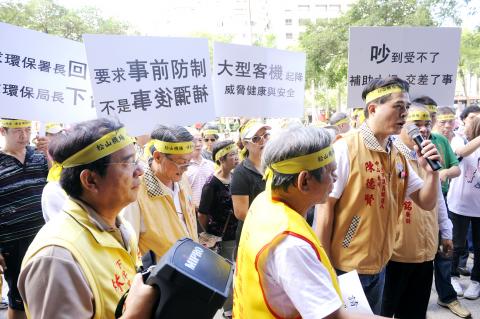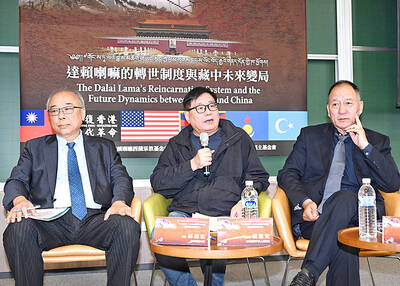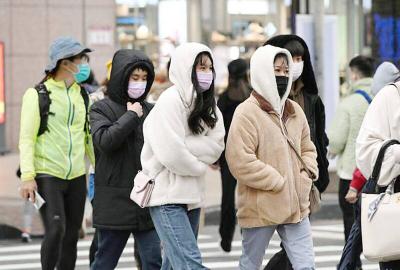Residents living close to Taipei Songshan Airport protested outside the Environmental Protection Administration (EPA) yesterday, saying the government should compensate them as quickly as possible for tolerating noise caused by landing and departing aircraft.
The protesters, led by candidate for Taipei City councilor Chen Teh-sien (陳德賢) of the Taiwan Solidarity Union, were mainly from Datong (大同) and Zhongshan (中山) districts. They said the Civil Aeronautics Administration (CAA) had promised it would compensate 100 households living in the designated noise control zone every year by installing soundproof facilities.
“There are about 100,000 households located in the noise control zone,” the protesters said in a statement. “However, 10 years have passed and only 5,092 households have been compensated.”

Photo: George Tsorng, Taipei Times
The protesters said decibel levels measured by the CAA at selected locations were much lower than those measured by the residents themselves. They said noise pollution would be much higher when direct flights between -Songshan and Tokyo’s Haneda airports are launched later this month.
“The noise from the airport has caused long-term damage to the residents’ health,” Chen said. “Taipei City’s Department of Environmental Protection is responsible for executing the installation of soundproof facilities and should not pass the buck. It obviously has colluded with the CAA by only recognizing the standards that the CAA set for giving out compensation.”
The EPA said it would soon organize a meeting which the CAA and residents could attend to talk about solutions.
“We will focus on two things. One will be the actions taken by the CAA to reduce the noise generated by aircraft landing and taking off and the other will be to see if there is any other way to make soundproof facilities available sooner,” said Hsieh Yein-rui (謝燕儒), director of the EPA’s Air Quality Protection and Noise Control Department.
Hsieh said compensation for noise control was funded by aircraft landing fees paid by the airlines using Taipei Songshan Airport. To facilitate the installation of soundproof facilities, the Department of Environmental Protection has divided the residents into three categories based on decibel measurements. Those living in the Category III area, which has a measured decibel of 75 or above, will be given priority, followed by those in the Category II and Category I areas respectively.
EPA statistics showed the CAA has yet to finish the installation of soundproof facilities in Category III areas.
“In the past, Songshan could collect aircraft landing fees of about NT$100 million [US$3.25 million] per year,” Hsieh said. “The launch of the high-speed rail service hurt domestic flight services badly, which in turn caused the landing charge to drop drastically to approximately NT$30 million per year.”
The CAA said the locations where noise levels were measured were determined by the CAA, the department as well as local residents and, therefore, cannot call the shots.
Statistics from the CAA showed that approximately NT$1.5 billion has been spent on noise control between 2000 and this year and NT$900 million was used for the installation of soundproof facilities.
A total of 5,165 households in the noise control zone are qualified for compensation for soundproof facilities. So far, 50 have yet to have them installed, the CAA said.

ALIGNED THINKING: Taiwan and Japan have a mutual interest in trade, culture and engineering, and can work together for stability, Cho Jung-tai said Taiwan and Japan are two like-minded countries willing to work together to form a “safety barrier” in the Indo-Pacific region, Premier Cho Jung-tai (卓榮泰) yesterday said at the opening ceremony of the 35th Taiwan-Japan Modern Engineering and Technology Symposium in Taipei. Taiwan and Japan are close geographically and closer emotionally, he added. Citing the overflowing of a barrier lake in the Mataian River (馬太鞍溪) in September, Cho said the submersible water level sensors given by Japan during the disaster helped Taiwan monitor the lake’s water levels more accurately. Japan also provided a lot of vaccines early in the outbreak of the COVID-19 pandemic,

Kaohsiung Mayor Chen Chi-mai (陳其邁) on Monday announced light shows and themed traffic lights to welcome fans of South Korean pop group Twice to the port city. The group is to play Kaohsiung on Saturday as part of its “This Is For” world tour. It would be the group’s first performance in Taiwan since its debut 10 years ago. The all-female group consists of five South Koreans, three Japanese and Tainan’s Chou Tzu-yu (周子瑜), the first Taiwan-born and raised member of a South Korean girl group. To promote the group’s arrival, the city has been holding a series of events, including a pop-up

TEMPORAL/SPIRITUAL: Beijing’s claim that the next Buddhist leader must come from China is a heavy-handed political maneuver that will fall flat-faced, experts said China’s requirement that the Dalai Lama’s reincarnation to be born in China and approved by Beijing has drawn criticism, with experts at a forum in Taipei yesterday saying that if Beijing were to put forth its own Dalai Lama, the person would not be recognized by the Tibetan Buddhist community. The experts made a remarks at the two-day forum hosted by the Tibet Religious Foundation of His Holiness the Dalai Lama titled: “The Snow Land Forum: Finding Common Ground on Tibet.” China says it has the right to determine the Dalai Lama’s reincarnation, as it claims sovereignty over Tibet since ancient times,

Temperatures in some parts of Taiwan are expected to fall sharply to lows of 15°C later this week as seasonal northeasterly winds strengthen, the Central Weather Administration (CWA) said today. It is to be the strongest cold wave to affect northern Taiwan this autumn, while Chiayi County in the southwest and some parts of central Taiwan are likely to also see lower temperatures due to radiational cooling, which occurs under conditions of clear skies, light winds and dry weather, the CWA said. Across Taiwan, temperatures are to fall gradually this week, dropping to 15°C to 16°C in the early hours of Wednesday